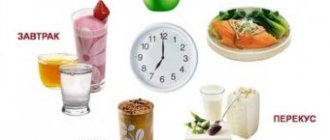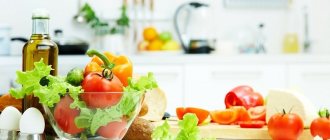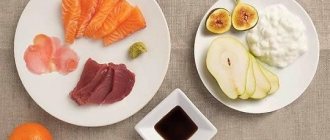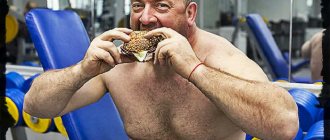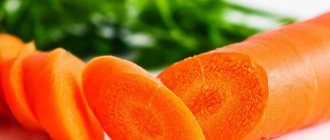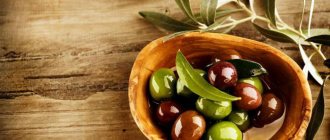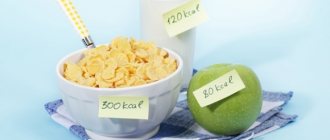The vast majority of people, in our fast-paced age, are increasingly thinking about the topic of proper nutrition. There are several important reasons for this. Firstly, proper nutrition allows you to feel cheerful and fresh, and secondly, it helps to maintain weight in a certain category.
Today we will look at a menu for 1300 calories per day. Looking ahead, it should be noted that this menu is perfect for both men and women, both for losing weight and maintaining weight.
1300 calorie meal
The minimum daily calorie intake for adults is 1200 calories. However, when doing physical labor or sports, this figure increases sharply and amounts to 1500 calories or more. Thus, a balanced menu of 1300 calories will be the golden mean.
The main condition is to find the right balance with kbju. It is the clear distribution of the main groups of elements that is the key to the success of any balanced diet.
Kbju is a generally accepted formulation of the main elements (calories, proteins, fats, carbohydrates) when compiling a pp menu.
Norm and formula
Balancing kbju is strictly individual and is developed directly for a specific person.
Factors influencing the calculation:
- Sex differences;
- Age category;
- Lifestyle at the time of counting;
- The goal, that is, what you are trying to achieve - losing weight, gaining weight or maintaining it;
- Human metabolism.
Next, the calculation formula is used. There is no strictly defined formula, so nutritionists use the most effective ones, based on the above characteristics.
We will use a formula that is generally accepted by many nutritionists from different countries.
Calculation formula for women:
9.99 x exact weight in kg + 6.25 x exact height in cm –4.92 x full age in years – 161
Calculation formula for men:
9.99 x exact weight in kg + 6.25 x exact height in cm – 4.92 x full height in years + 5
We get a strictly defined figure, these are the calories that you spend every day, even if you just lie on the couch and sometimes move your arm or leg.
Next, you should multiply the resulting amount by KA (activity coefficient).
The coefficient directly depends on lifestyle:
- Absolutely passive image or permanently sedentary work, no sports, KA is 1.2;
- Light physical activity twice a week, KA is 1.4;
- If you are on the move or visit the gym 3-5 times, then KA is 1.46;
- Full-time classes in the gym 5 times a week – 1.55;
- Daily sports activities – 1.63;
- Exercising twice a day, throughout the week – 1.72;
- Work associated with constant physical activity, or playing sports with full effort twice a day – 1.9.
For example, let’s take my indicator and calculate the norm together:
1337 x 1.4 = 1872 kilocalories (kcal).
This is exactly the amount of food my body needs to constantly maintain weight.
To gradually lose weight, you need to subtract ten percent, and to gain weight, add it accordingly.
1872 – 10% = 1685 kcal. For weight loss.
1872 + 10% = 2059 kcal. For recruitment.
You can increase the percentage for faster results. However, in this case, the body will be subject to severe stress, and this can lead to undesirable consequences.
It is extremely difficult to absolutely maintain these numbers, so they resort to a “calorie corridor.” The minimum limit of which drops to – 250 kcal, and the maximum rises to + 100 kcal.
Calculate your ideal weight
1300 calorie diets with recipes
A simple menu for a given amount of calories, very comfortable and convenient, you won’t have to go hungry.
The advantages include:
- Accelerated metabolism;
- Improvement of skin;
- The condition of hair and nails noticeably improves;
- Increased tone, improved well-being;
- The appearance of lightness.
Minuses:
- Feeling hungry in the first days;
- Fast fatiguability;
- Dizziness;
- Fainting.
With prolonged use of a diet for such a number of calories, there is a decline in efficiency, as well as a decrease in metabolism.
Weekly menu with simple ingredients
All recipes are very simple, prepared from available products.
Day 1 - 1314 kcal. (BZHU - 78/31/180)
7.30 – 220 g of oatmeal, prepared with low-fat milk, with the addition of 60 g of fresh berries. Walnut - 10 g. Black coffee or unsweetened tea.
11.30 – green apple – 170 g.
14.30 – 120 g buckwheat porridge with milk 1.5% fat. Salad-250 g: cucumber, tomato, green. peas, carrots, egg, yogurt.
16.30 – banana – 120 g. Herbal tea.
18.30 – chicken breast salad with vegetables (tomato, cucumber, herbs), dressed with yogurt. Chicory with milk.
19.30 — A glass of kefir with one slice.
Day 2 - 1301 Kcal (BJU -110/32/138)
7.30 – 210 g low-fat cottage cheese – 200 g, banana – 100 g. Black coffee or tea without sugar.
11.30 – orange – 130 g, raw carrots – 150 g.
14.30 – boiled brown rice – 120 g, steamed salmon small portion, 250 g, seasoned vegetable salad 1 tsp. butter - 200 g.
16.30 – 30 g of black bread with low-fat cottage cheese and one tomato. Tea.
18.30 – small portion of omelette with vegetables, chicory with milk.
19.30 - green apple.
Day 3 - 1305 Kcal (BZHU-100/43/133)
7.30 –220 g oatmeal cooked with low-fat milk. Add one grated apple and one teaspoon of cinnamon to the porridge. Coffee.
11.30 – half a grapefruit, walnut – 10 g.
14.30 – vegetable soup, one serving. 30 g rye bread with herring.
16.30 – yogurt with berries (can be fresh frozen).
18.30 – cottage cheese casserole – 200 g without sugar. To prepare, you need to take low-fat cottage cheese, kefir, egg, and oat bran. Bake like a regular casserole. Tea.
Just before bed – chicory with milk + slice.
Day 4 - 1300 Kcal (BJU - 109/20/170)
7.30 – 80 g of dry muesli diluted with kefir (200 ml). Half a grapefruit, black coffee or tea.
11.30 – green apple – 180 g.
14.30 – chicken breast soup: chicken fillet – 80 g, potatoes – 100 g, buckwheat – 25 g, green peas – 50 g, herbs – 15 g. One slice.
16.30 – 50 g of black bread with low-fat cottage cheese and one tomato.
18.30 – steamed white tilapia fish 190 g. Vegetable salad: tomato – 100 g, cucumber – 100 g, green peas – 50 g, radishes – 50 g, carrots – 50 g, greens – 15 g, season with yogurt – 60 ml.
Menu for one day
In order for weight loss to proceed at an accelerated pace, you need to rationally distribute allowable calories. Nutritionists recommend dividing the entire daily diet into 5 meals (3 main meals and 2 snacks between them).
The optimal percentage ratio is: breakfast 30%, snack 5%, lunch 40%, afternoon snack 5%, dinner 20%.
The first meal should consist of complex carbohydrates, with a small amount of healthy fats allowed. For dinner, it is better to leave protein foods, complemented by a side dish containing fiber.
Important! There is an unspoken rule regarding the volume of food consumption: one serving should correspond to the size of your palms folded together.
Additionally, you must drink at least 1 liter of drinking water. If possible, it is better to avoid salt altogether, since it retains excess fluid in the body.
Be sure to read: Menu for 1000 kcal per day: how much weight can you lose in a week?
Even an optimally selected diet, generously seasoned with salt and spices, will not allow you to lose weight, since water will not be able to remove toxins and other harmful substances, and the diet will be useless.
Healthy breakfast
Millet porridge with pumpkin can be a good start to the day. It will give only 174 kcal per 100 grams. Thus, after eating only 200 g of porridge, you can supplement your breakfast with unsweetened tea with a slice of cheese, a glass of organic yogurt or sliced vegetables.
Recipe for millet porridge with pumpkin
Recipe for millet porridge with pumpkin
Ingredients:
- millet cereal – 100 g;
- pumpkin – 100 g;
- water – 25 ml;
- milk – 1 glass;
Preparation:
- Cut the peeled pumpkin into small cubes. If you want to get a dish with a more uniform consistency, you can grate the vegetable on a coarse grater.
- Mix half the milk with water and boil.
- Place the pumpkin into the boiling liquid and cook until half cooked.
- Rinse the cereal well.
- Pour the remaining milk into the pan, add the millet and cook, covered, over low heat for about half an hour.
Out of habit, you cannot season porridge with butter. It will double the calorie content of the dish.
Full lunch
200 grams of beef goulash with a side dish of boiled buckwheat is suitable as a main dish. Additionally, you can allow a light salad (for example, sauerkraut per 200 g is only 57 kcal). The calorie content of the entire meal is 480 calories.
Beef goulash recipe
Beef goulash recipe
Ingredients:
- beef fillet (veal is possible) – 200 g;
- onion – 1 head;
- grated tomatoes – 100 ml;
- flour – 1 tbsp. l.;
- water - according to circumstances;
- vegetable oil – minimum amount for pre-frying;
- salt - a small pinch.
Preparation:
- Cut the meat into pieces of the same size.
- Chop the onion in any convenient way.
- Spray the pan with oil and fry the vegetable in it, then add the beef, cover and leave to simmer.
- You can use ready-made paste, but it is better to take 1 large tomato, remove the skin from it and wipe it.
- As soon as the meat has turned white, add flour and tomato paste. Simmer until the beef is tender.
If desired, the dish can be sprinkled with chopped herbs.
Light dinner
Baked pink salmon with a salad of tomatoes, cucumbers and peppers will be an excellent end to the day, as fish is a rich source of protein. The fiber contained in vegetables will help in its absorption. The total energy value of dinner will be 320 kcal.
Recipe for baked pink salmon
Recipe for pink salmon baked in the oven
Ingredients:
- gutted pink salmon carcass without head – 1 pc.;
- green onions - 2 feathers;
- lemon – 1 pc.;
- olive oil – 30 ml;
- dried garlic – 5 g;
- ground pepper – 5 g;
- hops-suneli – 8 g;
- rosemary and basil - a couple of sprigs;
- cucumber, tomato, bell pepper - 1 pc.
Be sure to read: Bormental: food diary, diet principles, simple recipes for weight loss
Preparation:
- Rinse the fish carcass thoroughly and dry it with a paper towel.
- Prepare a piece of foil and place it on a baking sheet so that the shiny side remains on the outside. Lightly oil the sheet.
- Rub the inside of the fish with granulated garlic and place it on foil.
- Prepare aromatic filling. To do this, cut the lemon into slices and rinse the greens thoroughly.
- Make cuts on one side of the pink salmon and insert lemon slices there. Place the remaining citrus along with the herbs inside the fish.
- Sprinkle seasonings on top of the workpiece, wrap in foil and leave in a warm place for 15 minutes so that the pink salmon begins to absorb the smells of the spices.
- Place the fish in an oven heated to 220 degrees and bake for about half an hour. After this, uncover the fish, reduce the heat to 160 and continue cooking until browned.
While the pink salmon is baking, make a vegetable salad. Cucumber, tomato and pepper are cut into slices and sprinkled with olive oil.
Advice! It is impossible to completely eliminate fat from your diet. However, one trick helps to significantly reduce its amount. If you put a regular spray bottle on a bottle of vegetable oil, this will allow you to distribute the fat over the surface in reduced volumes. Thus, the calorie content of the dish will be reduced by an average of 20%.
Options for breakfast, lunch and dinner can be varied at your own discretion. The main thing is to ensure that caloric intake does not go beyond acceptable limits. Snacks are a must between main meals.
Their nutritional value depends on the amount of BJU consumed previously. The most modest snack is an apple or a glass of low-fat fermented milk products. If breakfast was poor in carbohydrates, then you can eat 1 banana.
Basic rules of proper nutrition
There are a number of mandatory rules to ensure that food not only tastes good, but also brings maximum benefits.
- Meals should be eaten five times a day.
- The dish should not exceed 250 g.
- Water should be consumed up to three liters; juice, tea and coffee are not a substitute.
- Carbohydrates are consumed in the first half of the day, as they are absorbed over a long period of time.
- Protein, on the contrary, is absorbed quickly, and therefore it should be transferred to the second half of the day.
- An excellent source of fats are nuts.
- Fiber, as well as essential vitamins, can be found in fruits.
How to get out of a diet correctly
Anyone who has taken a weight loss course knows very well that losing extra pounds is only half the battle. The second part is to hold the resulting mass.
You should come out of the 1300 calorie diet slowly, one might say in stages.
There is no point in constantly being at this mark. The fact is that over time, the body adapts to your diet and the weight loss effect will disappear.
The amount of calories consumed should be increased gradually. For the first three days, add one hundred calories, then two hundred, three hundred until you reach your usual diet.
Expert advice
- You need to eat at specially designated hours.
- Look at things realistically. Experts advise a gentle approach - minus a kilogram in one week. The result of long-term weight loss lasts longer.
- Incentives. Give yourself occasional surprises after achieving intermediate results. This way you can cope with nervous tension more easily.
- Don't despair under any circumstances. We didn’t lose the treasured kilogram or overeat sweets, nothing bad happened. Return to eating healthy the next morning.
- Exercise. If you don't want to go to the gym, walk, do gymnastics.
- Swap out regular dishes for smaller ones.
It is necessary to clearly understand that no diet will help if there is no proper nutrition. When thinking about what to eat for lunch or dinner, pay attention to the amount of useful and active substances. Just one indulgence can undo all your efforts.
Diet menu for weight loss for a week
It is difficult to strictly maintain a value of 1300 kcal, so a deviation from the standard of 200-300 calories up or down is allowed. An approximate weekly menu option, discussed below, will allow you to start the process of losing weight without feeling hungry.
Monday (1100 kcal)
On the first day of the diet, you should try to reduce the nutritional value of your meals as much as possible.
An approximate diet is presented in the table.
| Eating | Name of the dish | Weight |
| Breakfast | Oatmeal with milk and berries | 200 g |
| Unsweetened tea | 200 ml | |
| Snack | Grated carrot salad | 160 g |
| Dinner | Boiled buckwheat | 100 g |
| Zucchini, cauliflower and pea stew | 230 g | |
| Afternoon snack | Fruit mix | 250 g |
| Dinner | Boiled chicken | 300 g |
| Pepper salad with tomatoes and tofu | 100g |
The next day you can increase the number of calories.
Tuesday (1450 kcal)
| Eating | Name of the dish | Weight |
| Breakfast | Cottage cheese | 200 g |
| Banana | 50 g | |
| Unsweetened coffee | 100 ml | |
| Snack | Grapefruit | 100 g |
| Dinner | Boiled salmon with bulugur garnish | 200 g |
| Assorted boiled vegetables (asparagus, Brussels sprouts, carrots, celery) | 300 g | |
| Afternoon snack | Canapes of grain bread, tomato and cheese | 80 g |
| Dinner | Vegetable casserole | 220 g |
| Cucumber and tomato salad | 190 g |
Be sure to read: Menu for 1800 and 2000 kcal per day: recipes from simple products
Wednesday (1350 kcal)
| Eating | Name of the dish | Weight |
| Breakfast | Boiled egg | 90 g |
| Apple baked with cinnamon | 80 g | |
| Kefir 1% | 200 ml | |
| Snack | Orange | 50 g |
| Cashew | 20 g | |
| Dinner | Chicken breast soup | 350 ml |
| Afternoon snack | Smoothie made from berries, cottage cheese and milk | 250 ml |
| Dinner | Fresh cottage cheese casserole | 180 g |
| Ryazhenka | 200 ml |
Thursday (1570 kcal)
| Eating | Name of the dish | Weight |
| Breakfast | Muesli with peach | 220 g |
| Apple | 50 g | |
| Green tea | 200 ml | |
| Snack | Biokefir | 200 ml |
| Dinner | Broth based on lean meat | 350 ml |
| Afternoon snack | Sandwich made from grain bread, cheese and pepper | 80 g |
| Dinner | Roast turkey | 100 g |
| Steamed vegetables | 300 g | |
| Low-fat milk | 200 ml |
Friday (1335 kcal)
| Eating | Name of the dish | Weight |
| Breakfast | Egg, pepper, cucumber salad and rye bread croutons | 200 g |
| Sugar free coffee | 100 ml | |
| Snack | Grated beets with garlic | 100 g |
| Dinner | Veal stewed with vegetables | 250 g |
| Afternoon snack | Orange fresh | 200 ml |
| Chocolate 75% | 20 g | |
| Dinner | Boiled squid | 150 g |
| Vegetable mix | 100 g | |
| Low fat yogurt | 200 ml |
Saturday (1100 kcal)
| Eating | Name of the dish | Weight |
| Breakfast | Oatmeal porridge with skim milk | 200 g |
| Baked apple | 50 g | |
| Snack | Kefir | 200 ml |
| Dinner | Steamed beef patties | 100 g |
| Vegetable casserole | 200 g | |
| Afternoon snack | Fruit smoothie | 200 ml |
| Dinner | Boiled cod with broccoli garnish | 300 g |
| Tomato juice | 220 ml |
Sunday (1570 kcal)
| Eating | Name of the dish | Weight |
| Breakfast | Berry muesli | 200 g |
| Pomelo | 100 g | |
| Snack | Walnuts | 30 g |
| Orange fresh | 100 ml | |
| Dinner | Steamed rabbit cutlets | 100 g |
| Braised cabbage | 300 g | |
| Afternoon snack | Curd and fruit cocktail | 190 g |
| Dinner | Vegetable side dish | 210 g |
| Piece of boiled turkey | 100 g |
After the first week of the diet has passed, you can go to the second round if you wish. The diet can be left the same or changed while maintaining the calorie balance. Who is not suitable for the 1300 calorie diet?
Despite the fact that the diet is considered lightweight, it also has a number of contraindications.
It is not recommended to adhere to it:
- people with gastrointestinal diseases;
- those experiencing increased physical activity;
- during pregnancy and lactation.
In all other cases, you can safely follow the 1300 calorie diet. It does not pose any health hazard.
